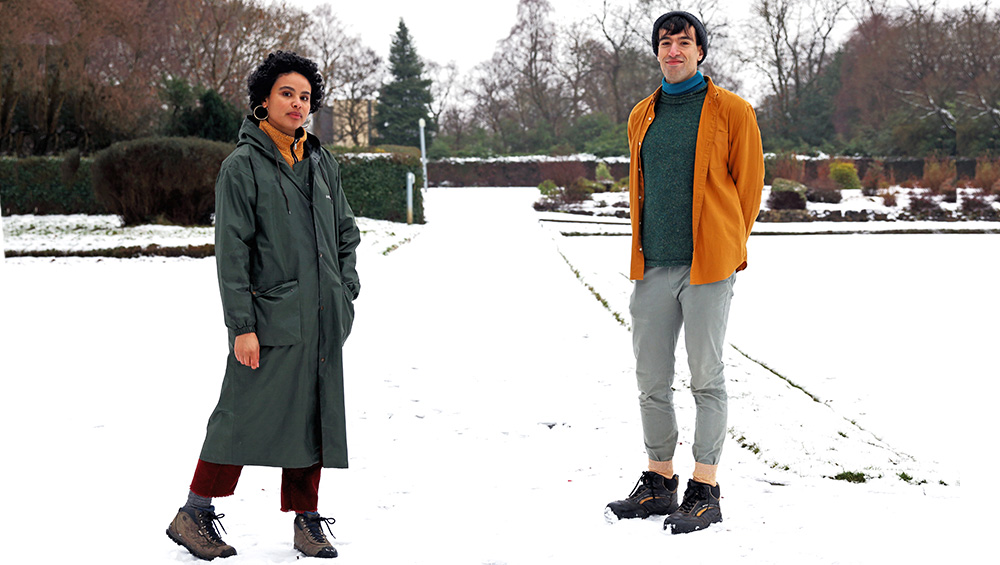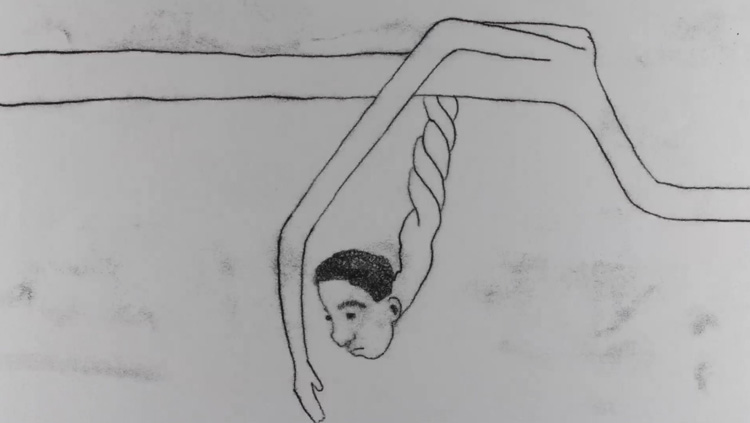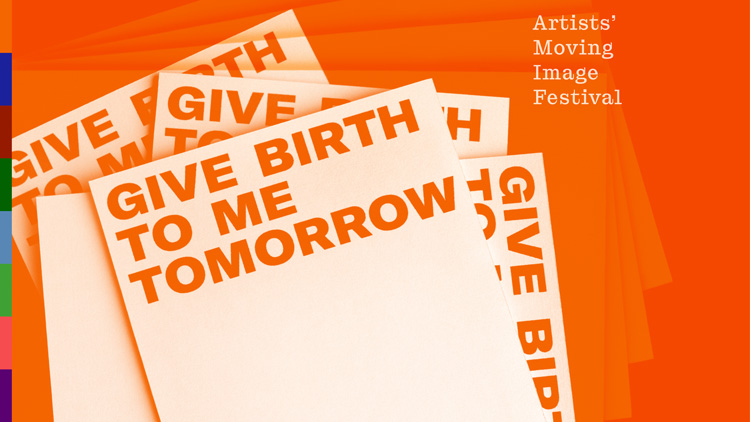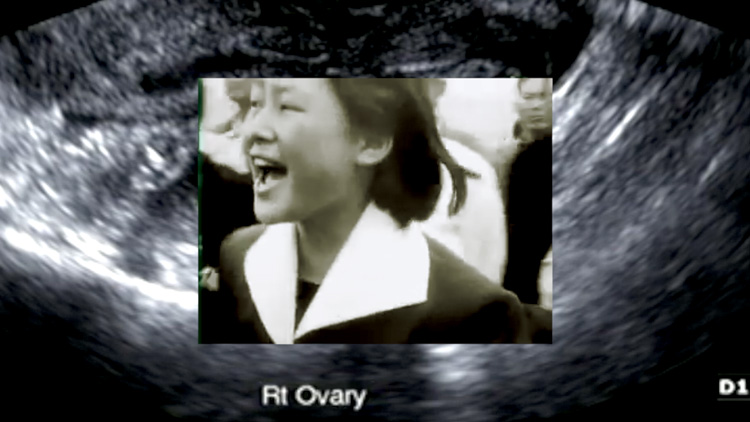
Tako Taal and Adam Benmakhlouf.
by CHRISTIANA SPENS
Give Birth to Me Tomorrow extends what was to be a weekend festival throughout 2021, inviting audience members to see an introductory selection of film works, recorded performances, animations and protest documentary, before participating in a full programme of virtual screenings and events, held over the next 11 months, around the lunar calendar.
The short films in the programme explore strategies for interruption, the deconstruction of a traditionally neo-colonial, white supremacist, capitalist, patriarchal cinema system, beginning with Fingernails on a Blackboard: Bella (2014) by Sharon Hayes, Miss Canadiana (2005) by Sherisse Mohammed and Camille Turner, Hear Me Out (2018) by Isabel Barfod, Lief (2019) by De’Anne Crooks and Born, Unborn and Born Again (2019) by Kyuri Jeon.
Tako Taal and Adam Benmakhlouf, who programmed the event, talked to Studio International via email.
Christiana Spens: What is the concept or approach that binds the films?
Tako Taal: For me, the films in this first event of our programme could be joined by their questioning of what it is to announce, or articulate, individual and collective presence. We begin the programme with Fingernails on a Blackboard: Bella, which digs into what is demanded from a voice, what it means to be heard clearly and for what is being said to be taken seriously by the public. The preceding works follow a more general arc around how the performance of the voice [through prayer or the language used to describe illness] forms and shapes our body or bodies.
_stills_01.jpg)
Sharon Hayes, Fingernails on a blackboard: Bella, 2014. Analogue video transferred to digital, colour, silent, 16 mins. Courtesy of the artist and Tanya Leighton, Berlin.
Adam Benmakhlouf: Organising the festival around artists’ moving image is as challenging as it is exciting. Under this grouping, there is a huge diversity of practices that can include documentary, scripted drama, dance, performance, animation, text, collage and abstraction. Experimental artist practice contains the promise of a radical release from the parameters and expectations of conventionally produced moving image that we see in films and TV. At the same time, there are some instances of film and television right now that are rewriting the rules in amazing ways, too. Within artists’ moving image, the level of exposition, the pace and the textures can be much more resistant to immediate understanding. Crucially, this allows new vocabularies and ways of feeling and thinking, and this is particularly urgent when it comes to speaking about lifestyles, experiences and situations that can be frequently underrepresented or chewed-up by the beats of mainstream television and cinema. In these contexts, it’s difficult to speak about the insidious effects of unbalanced power dynamics, at the same time as being answerable to hierarchies of production and commissioning that are threaded with the presumptions and habits of hegemony. For me, the organising principle that emerged was to find the most effective examples of artists’ moving image that make the most of the relatively increased freedom here to communicate a level of nuance about often-politicised realms of experience.
CS: How do the different films, and watching them all together, change the meaning of the others, through this selection?
AB: It’s important that the films are distinct from one another. I started from a point of recognising the variety that’s possible in artists’ moving image, and that was one of my main motivators for being interested in programming the festival. I wanted to stay with this unruliness when it came to the look or way that the films have been made. How this played out practically was that we started with a longlist of works and artists, then selected each work to be included on its own merits. This meant that when we were putting together the selection for the first episode, we spoke – from what I remember – much more about the energy or overall feel of individual works, and paid more attention to smaller details or recurrences that might allow for an arc or way of watching them together that didn’t diminish their impact by being too randomly or haphazardly crowded or sequenced. In this way, the themes that possibly bring some works nearer others came out from the selected works, rather than us beginning with an overly programmatic intention and keyword-searching for artists that could fulfil our intended thematic.
TT: I agree, programming around a theme or themes was the last way I wanted to work. I remember a way we thought about the correlation was in the sense of a party or how a group of friends may come together through association. Some people may be closely tied, whereas another person may not know A or B but is pals with C, so there is a tangential connection. I think in arranging this grouping and showing these films together, it was less about changing the meaning, which is itself not fixed, of each work through proximity, but allowing for multiplicity.

Isabel Barfod, Hear Me Out, 2018. Animation, 4 min 45 sec. Courtesy of the artist.
CS: There is a sense in Hear Me Out (2018) by Isabel Barfod, as well as in Fingernails on a Blackboard: Bella (2014) by Sharon Hayes, that as audience members we are being brought into the internal dialogues or private discussions of others, about subjects such as faith, politics and how we relate to one another. Do you expect the reaction to be one of increased empathy and relation to the perspectives, or a sense of distance and alienation as a result of simply hearing and seeing another perspective, rather than being involved in the discussion? Will there be scope for audiences to continue these conversations?
AB: I think that’s a familiar and wide dichotomy, and the kind of either/or that artist’s moving image is particularly good at complicating and confounding. When it comes to audiences’ senses of intimacy or closeness, empathy or alienation, Hear Me Out and Fingernails on a Blackboard: Bella use sophisticated means to engage audiences in unusual ways. In Sharon Hayes’s work, there’s the privacy of seeing into this room where a politician is receiving speech therapy. Rules of presentation and persuasion would usually suggest that, for a public figure, it’s not advisable to share this part of your life. This kind of training to speak to audiences is undergone most successfully when it’s imperceptible to the listener. The work refers to the body of [the feminist and US congresswoman] Bella Abzug, her jaw, shoulders, breath, mouth, tongue, as she makes non-verbal sounds “Mmmmmmm”. Yet the whole form of this work is white text on an ultramarine background, and transferred using an analogue video titler from the 1980s – technology from the time the tape was first made. There’s much more of a sense of encounter with the moving image, it’s a form of address and, in this way, the audience begins to read the lines almost as a script, becoming implicated as both the student and the teacher, and there’s the unavoidable consequence of being more conscious of one’s body and voice.
Similarly, with Hear Me Out, animation is used to pull away from the usual processes of lens-based practices, and use recorded interview dialogue in a way that changes the interaction with what is being said. The intrigue of the drawing happening on screen allows for the hesitations and silent thinking that might otherwise be removed, or cause the listener to lose interest. Instead, they become the openings for these visions that Barfod animates. What comes out is an imaginative treatment of the interviews and research that centres on the body and visions of bending, being squashed and stretching. Coming back to the details, there’s this trace of the ink that seems to be from a monoprinting process that brings out another way of relating to the image, and activates the audience to think about how the illusion of movement, depth and space is coming around. For me, these visual strategies feel like surprising ways that the artists situate audiences in relation to the voices that are heard or read, and the experiences and research that are related through moving image.
TT: For the forthcoming screenings, there will be a parallel event where the audience will have an opportunity to have conversations around the works. In planning, we thought about these events as a kind of reading group, but for artists’ moving image. These events will have a limited capacity so that dialogue is possible: as I found through attending various online events last year, making conversation possible and pleasurable in these Zoom spaces is a delicate thing. To open up these conversations further, the meetings will be transcribed and communicated through text only. I realise now that, in these events, we are following a similar process to the Hayes’s work, Fingernails on a Blackboard: Bella.

Sherisse Mohammed and Camille Turner, Miss Canadiana, 2005. SD video, 3:4, 7 min 47 sec. Courtesy of the artist.
CS: I enjoyed Sherisse Mohammed and Camille Turner’s Miss Canadiana (2005), a recorded performance piece in which Turner takes on the persona of a patriotic beauty queen, “a hyper-feminised version of beauty”, blurring fantasy and reality in a fascinating and comical piece. Can you tell me more about how you came across this film and what you feel it says about the performance of femininity and patriotism in today’s climate?
AB: Through the Cooper Gallery in Dundee’s exhibition Ambiguous Becoming: Artists’ Moving Image from Canada, I’d come across a collaborative work by Turner, with Jérôme Havre and Cauleen Smith. Smith featured in AMIF 2019, too. This was how I first encountered Miss Canadiana and then the documentation that we’ve included in the first episode. As well as what you’ve mentioned already, Turner herself describes where, in part, this work begins and finds itself: “My image as Miss Canadiana points to the contradiction of the Canadian mythology. My body, as a representative of Canadian heritage, is surprising only because blackness is perceived as foreign in Canada.” Along with femininity and patriotism, Turner expressly addresses ingrained attitudes of white supremacy. Within Miss Canadiana, Turner self-styles herself as a public figure – which in some ways brings us back to Hayes’s work documenting Bella Abzug in vocal training to improve her political career. One of my favourite parts of Miss Canadiana is that, throughout the video, Turner describes in detail how the performance circulates, the effects it has on people she meets, and the specific strategies she uses to short-circuit the usual flows of adoration. It’s a powerful work for bringing out the constructedness of officialdom, but also its powerful persuasion.

Give Birth to Me Tomorrow, 2021. Photo: Maeve Redmond.
CS: With Give Birth to Me Tomorrow, you have taken the decision to extend the programme beyond the typical weekend festival format, so that audiences can engage with the programme over the next 11 months. Can you tell us a little more about the ideas behind this decision, and how the programme will evolve?
AB: As someone who works a lot in different capacities, the Monday to Sunday week doesn’t look or come to me in the way that the weekend festival structure would presume it does. Often, the big Friday evening, all day Saturday and Sunday conference style of events can pass me by, or is exhausting in how it extends or overlaps with an existing working week to such an exaggerated extent. Above anything else, this didn’t seem the best way to have audiences pay as much attention to the selected works, particularly the kind of careful watching that artists’ moving image deserves. These ideas had been with us since the beginning of our conversations about programming the festival and, with the inevitable restrictions that were brought about throughout 2020, it meant that some kind of change would definitely be required. Having each work come as an event in itself, but nevertheless being a part of a distinctive line of programming, brought around this slow-motion style of festival that creates a community of audience members and, hopefully, can allow for greater access and shared insight.
TT: Another desire to stretch the programme over the year is a way of being obstinate and staying with the ideas all the films in the programme provide for as long as possible. There is a tendency with events or issues for them to spread quickly and suddenly be dropped the next week. I think this has less to with desire and more with capacity. With Give Birth to Me Tomorrow, there is an urgency with many of the works, but there is a demand for these ways of questioning that the works provoke to remain with us if we want to think about the world and our futures differently. By having this programme follow lunar events roughly every six weeks throughout the year, it was a way of promoting a kind of repetition where you can return and pick up similar lines of thought, and that feels a necessary luxury right now.

Kyuri Jeon, Born, Unborn, and Born Again, 2020. Colour, 16:9, Stereo, 12 min 38 sec. Courtesy of the artist and Cinema Dal.
CS: Born, Unborn and Born Again (2019) by Kyuri Jeon documents Korean pro-choice protests, along with a performance, or testimony, that lays out the complex social and cultural history of abortion, discrimination against female babies, the idea of being “unborn” and the personal attempt to reconcile, or at least explain, this phenomenon. This is also where the title of the programme came from. Can you explain how the ideas of this film, in particular, tie in with the ethos of Give Birth to Me Tomorrow?
AB: Born, Unborn and Born Again was a work that Tako brought on our residence at Cove Park [artists’ residency in Helensburgh, Scotland] in October last year. I was immediately affected by how it followed so many different social and biographical events, and combined several kinds of footage, such as screen captures and mobile phone recordings. There’s a self-reflection to the voiceover that features throughout the film in how it is structured as Jeon carefully repeats certain sentences with slight shifts in the tenses, syntax and punctuation, and draws out the delicate shifts that different words or grammatical choices can make. In the film, Jeon builds up these layers of mythology, memory and accounts of becoming acquainted with the 12 tenses in English. Gradually, these multiple lines of enquiry climax into one of the final phrases of the powerful bilingual text that is heard throughout, and from which we excerpted the title. At the time of the residency, I was reading Octavia’s Brood, a collection of visionary fiction edited by Walidah Imarisha and Adrienne Maree Brown, and this idea of speculating and projecting forwards, planning into the future was feeling so urgent – no doubt also because October 2020 felt as if it was part of a provisional and exceptional moment that is still continuing.

Kyuri Jeon, Born, Unborn, and Born Again, 2020. Colour, 16:9, Stereo, 12 min 38 sec. Courtesy of the artist and Cinema Dal.
At the same time, the demand Give Birth to Me Tomorrow related a lot to how we’d been speaking about the position of being programmers, and the relationship between what we wanted to show audiences, and how it would be consumed. The idea of a passive, bingeing audience feels like an extension of pacifying structures that bring about multiple levels of personal and political stasis. Similar to Jeon’s engagement with the grammar and the nuances of linguistic communication, in programming, we’ve heeded the possibilities of shifting some of the beats and usual flows of the festival. And with this phrase Give Birth to Me Tomorrow, in its oddness and effectiveness, it shines as an imperative, a demand, a wish to have a place in the future and an acceptance that in many ways, that isn’t something [anyone] can control.
TT: “I will have been born when you give birth to me tomorrow” is the one of the final lines in Jeon’s film. I was struck by this phrase because, for me, it is the weight it put on the collective to bear responsibility for the individual self or our singular being in this world. In this way, we are all implicated in the birthing of one another. Similarly, the state of being unborn, which leads to the gesture of unbirthing, led me to think about how to undo a structure or a set of relations. To think of this change as an unbirthing reminds me of the labour and gestation period before any being enters the world and how this period of growth is equally important. A process of unbirthing necessarily requires thought about how to restore this period of labour or gestation, as well as how to change to the birthed being, structure or community.
• Give Birth to Me Tomorrow, LUX Scotland and Tramway’s annual Artists’ Moving Image Festival, co-programmed this year by Tako Taal and Adam Benmakhlouf, will take place across the course of 2021.